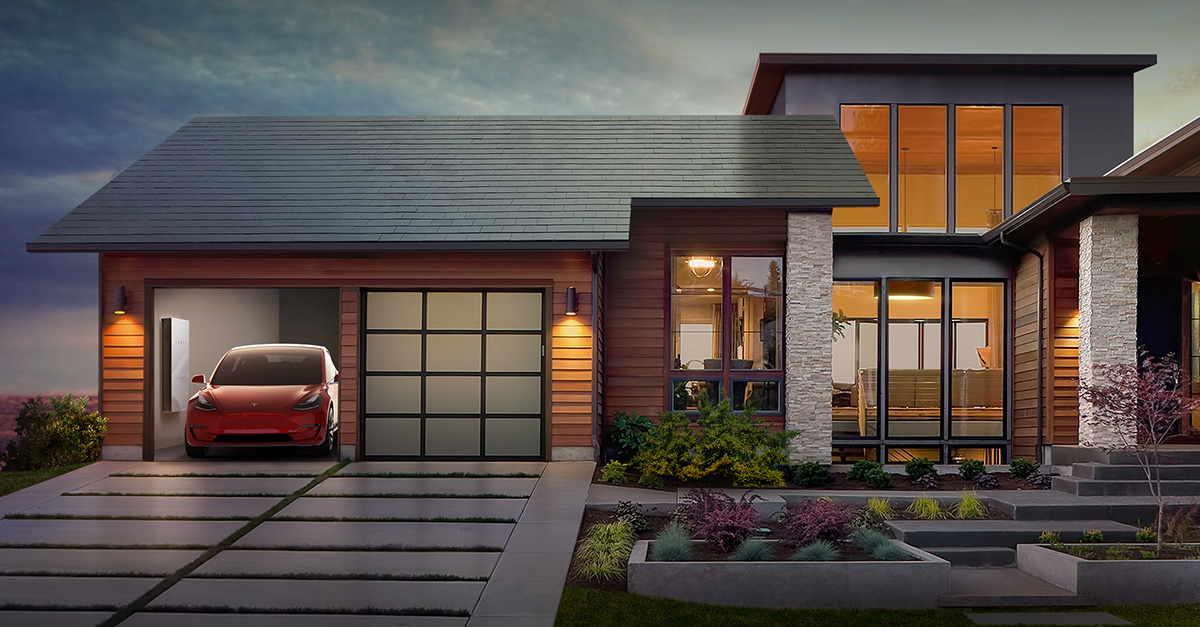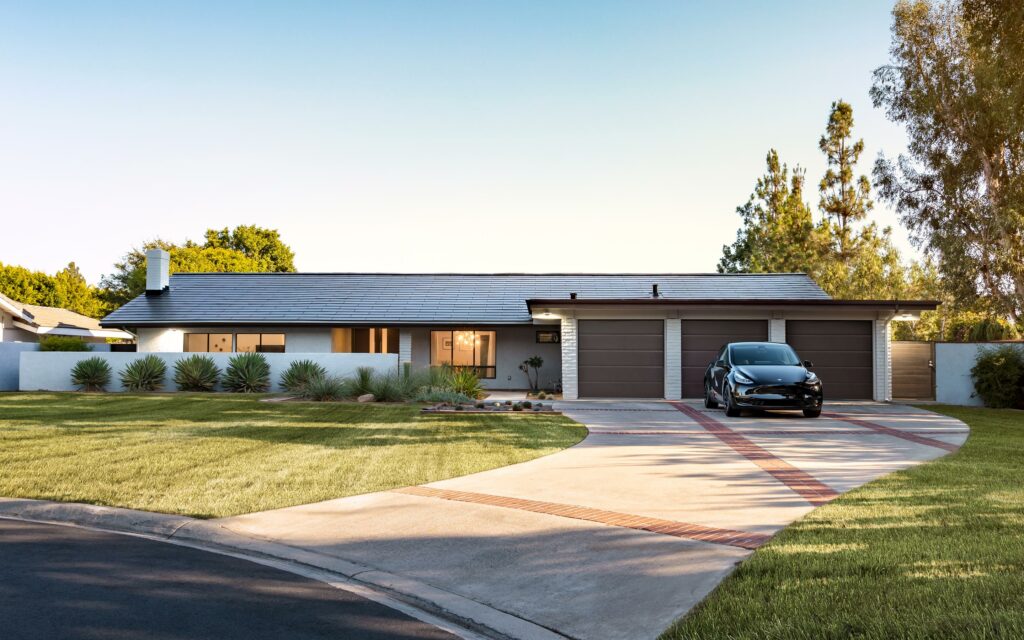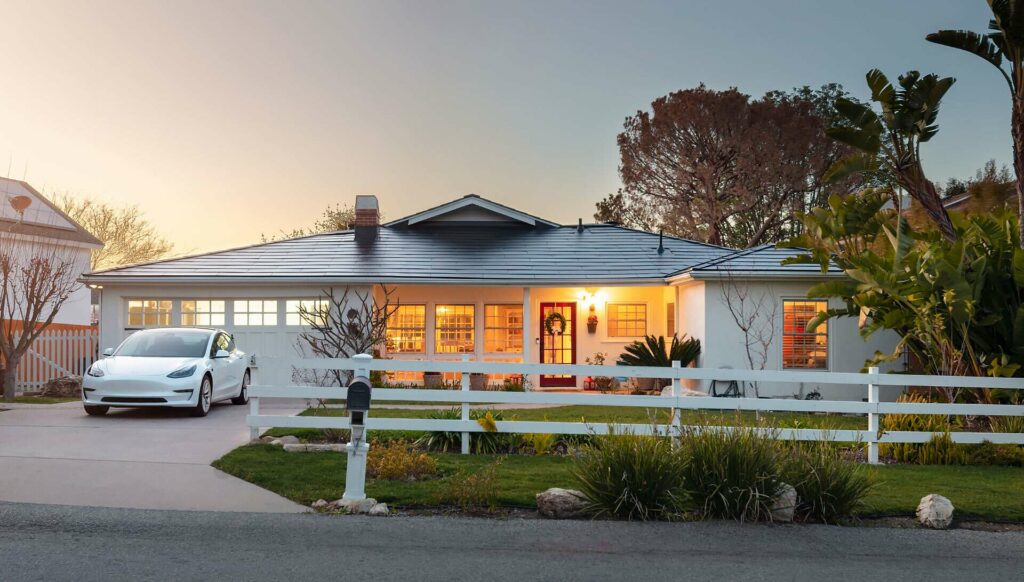
Are you thinking about solar power for your home and wondering if a Tesla Solar Roof is right for you?
Then you probably have many pressing questions about the Tesla Solar Roof’s ability to produce enough renewable energy to meet all of your home energy needs at an affordable price. Will it break the bank?
Another common concern is regional availability. Will you be able to find a certified local roofer to do the install in the near future — and sooner rather than much later as it’s been going across the United States?
Here you’ll find out everything you need to know about Tesla Solar Roof. Well-equipped with the facts, you will be able to make a fully informed decision before you invest in a Tesla Solar Roof for your home.
Also read: How do lithium-ion batteries work?
Table of Contents
What is the Tesla Solar Roof?
The Tesla Solar Roof is the creation of Elon Musk, Tesla’s founder and CEO, who describes his company’s mission like this: to “accelerate the world’s transition to sustainable energy.” In other words, Musk’s vision goes well beyond electric vehicles.
To show his commitment to bringing sustainable energy options to consumers, Tesla merged with the solar company SolarCity (previously owned by Musk’s cousins), to bring the solar roof concept to life.
For Musk, this means not simply attaching a mounted solar array to your roof, a setup known as rooftop solar (Although Tesla also offers rooftop solar panels).
Instead, with a Solar Roof installed solar shingles become an integral part of the very architecture of your home. In many cases, they completely replace conventional asphalt shingles.
Solar tiles may be used along with identical-looking non-PV glass tiles in a brand new roof. The relative percentage of the two depends on how much power you wish to generate and your home roof’s complexity.
Solar tiles can also be used over certain types of existing roofs, too.
The photovoltaic (PV) cells in a Tesla Solar Roof are actually embedded in sleek-looking roof tiles made of resistant tempered glass that is, according to Tesla, more than three times stronger than conventional roofing shingles.
Each solar tile is covered by a color louver film to enhance aesthetic appeal without compromising the ability of the solar cells to absorb the sun’s energy.
From the street, the films hide the PV cells from view, giving the solar roof a uniform-looking appearance much like a typical asphalt roof. You may not believe the roof doubles as a solar array when viewing it in this manner.
However, from directly above, the solar cells are completely transparent to incoming solar rays, fully capable of performing their task of generating electricity for you.

Is the Tesla Solar Roof better than asphalt shingles?
According to the Tesla website, the warranty on the tiles (glass only), power output, and weatherization (preventing water leaks) is for 25 years. By comparison, many asphalt shingle roofs are guaranteed for 25-30 years, but some are good for 50 years.
Incidentally, a metal or slate roof may last 50 years or more.
Tesla has not officially stated what the power output or the PV panel efficiency is, or even the current manufacturer of the panels.
According to a June 2021 article, Tesla installs Hanwha Q G6 solar cells in its rooftop solar projects, listed on the company website as having a >19% efficiency. It is not clear from the Tesla website if Tesla uses these for all its solar roof projects.
Here are the weatherization ratings for the Tesla Solar Roof followed by brief explanations of what they mean.
- Wind rating: ASTM D3161 Class F – highest rating out of three levels; will withstand winds at 110 mph for 2 hrs.
- Fire rating: Class A – highest rating out of three classes, providing best performance in fire
- Hail rating: ANSI FM 4473 Class 3 – up to 1.75” hail; the highest impact resistance is designated class 4
These results are comparable to those for asphalt shingles with 30-year limited lifetime warranties.
Tesla guarantees the inverter (the equipment that generates the electricity) for 12.5 years and states its efficiency is 97.5%. These values are typical in the solar industry.
Who can install a Tesla Solar Roof?
Installing a Tesla Solar Roof takes specialized know-how and training. As of 2021, there are only a few roofers in the United States who are certified to perform the installations.
Since each roof is unique, every installation must be customized. So, standardizing the installation to make it quick, easy, and scalable has been difficult. Musk has owned up to “big mistakes” and is working hard to correct them.
Also read: The real story of Elon Musk, the man who changed the world
How long does it take to install a Tesla Solar Roof?
Fortunately, the third version (V3) of the solar roof sold in 2021 features larger tiles that don’t need to be cut on site. It also has fewer pieces of hardware per tile. This means it can be installed more quickly than earlier iterations.
To give you some idea of the entire process, here’s a certified installer doing a 4-day install time lapse. Some customers report up to 10-14 days.
What types of Tesla solar tiles are available?
Initially, Tesla announced four types of glass solar tiles available for purchase. Those four types are:
- Textured
- Smooth
- Slate
- Tuscan
But based on customer online testimonials and photos, presently only textured glass appears to be offered.
Aerial photos from March 2021 of an install reveals a bronze Tesla Solar Roof, suggesting the Tuscan tile is coming to market.
#FremontFollies As promised, closeups of those entirely solar-free “solar testing fixtures” which are located at https://t.co/Mw2n745kzy. Have at it, analysts. $tslaQ $TSLA #ThereIsNoSolarRoof pic.twitter.com/iZJc0Ewyqp
— Machine Planet (@Paul91701736) March 1, 2021
How much does a Tesla Solar Roof cost?
Recently, Tesla announced steep price increases for its solar roof.
For example, a previous quote for a solar roof at $55K increased to $80-100K for the same-sized roof.
Tesla introduced the concept of roof complexity to justify its price increase. Using this notion, here’s another way to think of the cost:
- Simple: $14/sq. ft.
- Moderate: $16/sq. ft.
- Complex: $19.24/sq. ft.
A 2019 article used real numbers from Tesla Solar Roof owners (before Tesla introduced complexity considerations), found the actual price to be $21.85-$26.56/sq. ft.
By comparison, a traditional asphalt roof could be as low as $4/sq. ft. A tile roof could cost up to $20/sq. ft.
You can estimate how much your solar roof will cost using Tesla’s online configurator.
In 2021, Musk announced that every Solar Roof purchase must be bundled with a Tesla Powerwall storage battery which also went up in price in 2020. That will add at least $10,000 to the final price tag of your Tesla Solar Roof before any rebates or tax breaks.
Read more: Tesla Powerwall: Everything you need to know
How can you order a Tesla Solar Roof?
To purchase a Tesla Solar Roof, order online. You will need to know your approximate roof size and your monthly average energy usage to place an order. A $100 deposit is required. When you order, you must sign a contract and inform Tesla how you will pay for it.

How long will it take to get the Tesla Solar Roof?
The Tesla website states the installation will take 5-7 business days. The install happens after Tesla obtains all the necessary permits. Tesla doesn’t project how long that will take but customer online reports of 2-3 months or more are typical.
However, several online sources say the install itself may take two weeks, followed by months-long delays after signing. Tesla says it is working on significantly reducing that time.
What kind of roof is compatible with a Tesla Solar Roof?
According to the Tesla website, roofs with a pitch of 2:12 to 12:12 are compatible with a Tesla Solar Roof. But there is a lot more to consider.
Greater roof complexity may mean it will cost you significantly more for a Tesla Solar Roof than it would for someone with a “simple” roof.
Notably, a Tesla Solar Roof won’t work with a flat roof.
Tesla has a handy chart on its website that lists various types of roof materials which are compatible with PV panels and/or with solar shingles.
Should you invest in a Tesla Solar Roof?
Whether you should invest or not in a Tesla Solar Roof depends on many factors. Ultimately, the decision rests with you, the consumer.
You are an ideal candidate for a Tesla Solar Roof if you:
- Need a new roof
- Have a roof with “simple” or “moderate” roof complexity as defined by Tesla
- Are building a new home
- Do not have full retail net metering in your area. Without it, the mandatory Powerwall storage battery would likely save you money long-term.

Source: www.dsireusa.org
If one or more of the previous conditions doesn’t apply to you, rooftop solar instead of a solar roof may be a more economical way to meet all your energy needs sustainably. Compare prices using online calculators and seek out professional estimates from certified solar installers before making the financial commitment. Visiting Understand Solar is a great first step in the process.
Doing your research beforehand will ensure no regrets later.
What are some alternatives to Tesla’s solar roof from other companies?
Building Integrated Photovoltaics (BIPVs), such as the Tesla Solar Roof, have been on the market for several decades. They are beginning to take off as our climate crisis accelerates.
Today, there are several other companies offering BIPVs like solar shingles or solar tiles. With the exception of SunFlare, all the companies listed below, like Tesla, use monocrystalline solar modules. Unlike Tesla, these Solar Roof competitors post complete spec sheets on the PV panels used in their solar roof products.
- Luma Solar According to their website, Luma Solar “developed the first fully-integrated solar shingle in North America, perhaps the world.” They also state that their system is the only upgradeable one. Luma Solar offers optional home battery storage systems. Their panel’s complete spec sheets are available.
- CertainTeed For more than 115 years, CertainTeed has been installing roofs and other building materials. More recently, they have branched out into solar shingles and solar tiles. Apollo II shingles may be installed into a new or existing asphalt shingle roof. Apollo Tile II can be built into a new or existing concrete tile roof. Photovoltaic cell spec sheets are posted.
- SunTegra Offering both solar shingles to integrate with asphalt roofs and solar tiles to blend in with concrete tiles, SunTegra BIPV products feature their patented TegraVents. These are air channels under the modules, which prevent overheating and a loss of power output. Full product datasheets are linked to above.
- SunFlare Unique among the vendors profiled here, SunFlare offers thin-film solar cells compatible with flat and metal roofs. Rather than silicon, these cells contain copper indium gallium selenide (CIGS) which the company says is more environmentally friendly to produce compared to traditional silicon PV cells. Datasheets are available.
What is the payback period for a Tesla Solar Roof?
There is disagreement about what the payback period is for a Tesla Solar Roof. It will vary based on the electricity rates and roofing prices in your area.
There is no specific information or sample calculations on the Tesla site about how long it will take to recuperate your initial investment. There appears only this general statement under the heading Pay Less for Electricity: “Solar Roof is the only roof that can help pay for itself with the energy you produce.”
Sample calculations from 2019 and 2021 on reputable solar review sites showed that it could take 13 or 19 years before your solar roof would begin paying for itself.

Would a Tesla Solar Roof save me more money than traditional rooftop solar panels?
In 2019, Musk announced that the Tesla V3 Solar Roof would cost the same as or less than a homeowner’s electric bill + the cost of an asphalt composition shingle roof.
Tesla has not yet published any official statistics or even a case study with actual numbers.
A 2019 Electrek article analyzed real data using actual screenshots of calculations from a homeowner who had received an estimated comparison directly from Tesla. It showed a $6,000 savings (over 30 years and considering electricity costs) when purchasing a Solar Roof versus a “premium” conventional roof + rooftop solar.
In 2021, Solar Reviews did a theoretical comparison of a Tesla Solar Roof and a new asphalt roof with PV panels. They concluded rooftop solar would save $9,000. Electricity costs weren’t included. Of course, actual values depend on the roofing materials, PV panel efficiency, and your installers.
Notably, rooftop solar panels in 2021 clock in at $3/W on average. Tesla’s Solar Roof stands at $2.01/W. As you see from these examples, price per watt is only one factor among many to consider when figuring out how much a solar roof will actually cost you.
Read more: Tesla Roadster: What to expect from Elon Musk’s electric supercar
Wrap up on the Tesla Solar Roof
Carbon-conscious homeowners interested in lowering their home energy bill with renewable energy may choose a Tesla Solar Roof as a main part of their sustainable lifestyle. Along with increasing the property value of their home, a Solar Roof enhances its curbside appeal.
There’s much to learn about Tesla’s Solar Roof, a relative newcomer to the field of building integrated photovoltaics (BPIVs).
Based on the information here, if you decide you’re a perfect candidate for a Tesla Solar Roof to complement your Tesla Model S in the driveway and a Tesla Powerwall to store excess solar energy from your Solar Roof to recharge it, you’ll be cruising into a truly sustainable lifestyle.